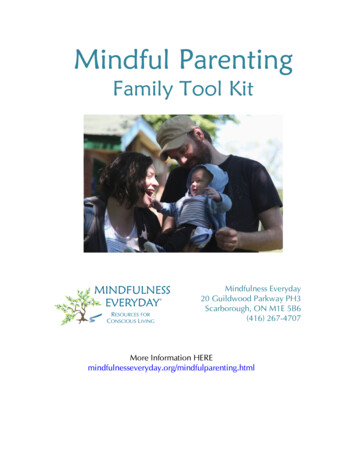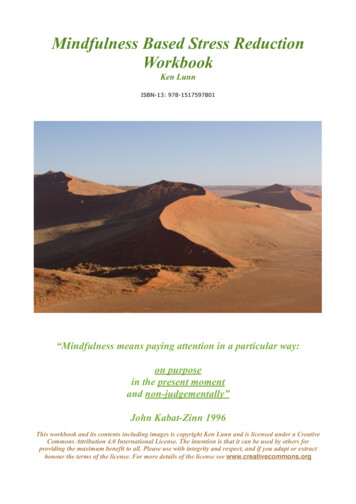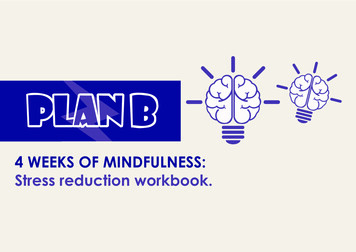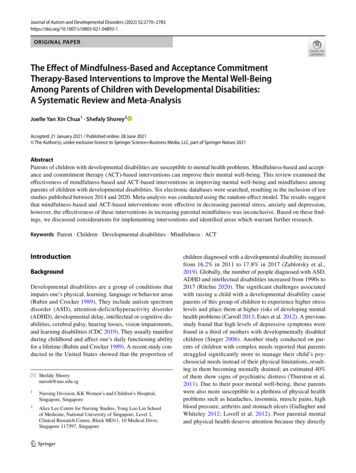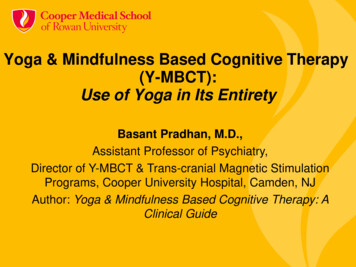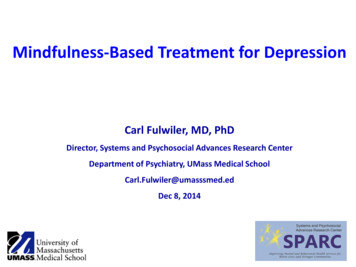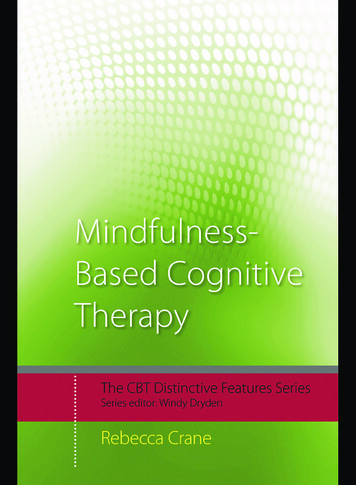
Transcription
Mindfulness-BasedCognitive TherapyMindfulness-Based Cognitive Therapy (MBCT) is increasinglyused in therapeutic practice. It encourages clients to processexperience without judgement as it arises, helping them tochange their relationship with challenging thoughts and feelings, and accept that, even though dif cult things may happen,it is possible to work with these in new ways.This book provides a basis for understanding the keytheoretical and practical features of MBCT. Focusing on amindfulness-based cognitive therapy programme that is offeredin a group context to those who are vulnerable to depressiverelapses, the text is divided into 30 distinctive features thatcharacterise the approach.Mindfulness-Based Cognitive Therapy: Distinctive Featuresprovides a concise, straightforward summary for professionalsand trainees in the eld. Its easy-to-use format will appeal toboth experienced practitioners and newcomers with an interestin MBCT.Rebecca Crane is an MBCT teacher and trainer and a ResearchFellow within the Centre for Mindfulness Research andPractice, School of Psychology, Bangor University, UK.
Cognitive behavioural therapy (CBT) occupies a centralposition in the move towards evidence-based practice and isfrequently used in the clinical environment. Yet there is no oneuniversal approach to CBT and clinicians speak of rst-,second-, and even third-wave approaches.This series provides straightforward, accessible guides to anumber of CBT methods, clarifying the distinctive features ofeach approach. The series editor, Windy Dryden, successfullybrings together experts from each discipline to summarise the30 main aspects of their approach divided into theoretical andpractical features.The CBT Distinctive Features Series will be essential reading forpsychotherapists, counsellors, and psychologists of all orientations who want to learn more about the range of new anddeveloping cognitive-behavioural approaches.Titles in the series:Acceptance and Commitment Therapy by Frank Bond and PaulFlaxmanBeck's Cognitive Therapy by Frank WillsBehavioral Activation Therapy by Jonathan Kanter, AndrewBusch and Laura RuschConstructivist Psychotherapy by Robert A. NeimeyerDialectical Behaviour Therapy by Michaela Swales and HeidiHeardMetacognitive Therapy by Peter Fisher and Adrian WellsMindfulness-Based Cognitive Therapy by Rebecca CraneRational Emotive Behaviour Therapy by Windy DrydenSchema Therapy by Jeffrey Young and Eshkol RafaeliFor further information about this series please -features
Mindfulness-BasedCognitive TherapyDistinctive FeaturesRebecca Crane
First published 2009 by Routledge27 Church Road, Hove, East Sussex BN3 2FASimultaneously published in the USA and Canadaby Routledge270 Madison Avenue, New York NY 10016Routledge is an imprint of the Taylor & Francis Group,an Informa businessThis edition published in the Taylor & Francis e-Library, 2008.“To purchase your own copy of this or any of Taylor & Francis or Routledge’scollection of thousands of eBooks please go to www.eBookstore.tandf.co.uk.”Ø 2009 Rebecca CraneAll rights reserved. No part of this book may be reprinted orreproduced or utilised in any form or by any electronic, mechanical,or other means, now known or hereafter invented, includingphotocopying and recording, or in any information storage orretrieval system, without permission in writing from the publishers.This publication has been produced with paper manufactured tostrict environmental standards and with pulp derived fromsustainable forests.British Library Cataloguing in Publication DataA catalogue record for this book is available from the British LibraryLibrary of Congress Cataloging in Publication DataCrane, Rebecca, 1964 Mindfulness-based cognitive therapy : distinctive features /Rebecca Crane.p. ; cm.Includes bibliographical references and index.ISBN 978-0-415-44501-6 (hardback : alk. paper) ISBN 978-0-415-44502-3 (pbk. : alk. paper) 1. Mindfulness-basedcognitive therapy. I. Title.[DNLM: 1. Cognitive Therapy methods. 2. Depressive Disorder therapy. 3. Mind Body and Relaxation Techniques.WM 425.5.C6 C891m 2009]RC489.M55C73 2009616.89 142 dc222008017140ISBN 0-203-88234-2 Master e-book ISBNISBN: 978 0 415 44501 6 (hbk)ISBN: 978 0 415 44502 3 (pbk)
Dedicated to the potential in each of us moment bymoment to be free from suffering, and to the endeavourto realise this.
ContentsAcknowledgementsForeword by Mark WilliamsIntroductionAbbreviations usedPart 1 THE DISTINCTIVE THEORETICAL FEATURESOF MBCT1 An integration of Mindfulness-Based StressReduction and Cognitive Behavioural Therapy2 Underpinned by the cognitive theory ofvulnerability to depression3 Learning skills to reduce the risk of depressiverelapse4 The signi cance of automatic pilot5 Modes of mind: doing''6 Doing mode in action: the effects ofrumination7 Doing mode in action: the effects ofexperiential avoidanceixxiiixviixxiii1391521273135vii
CONTENTS8 Reacting and responding to experience:avoidance and approach9 Modes of mind: being''10 Body sensationsÐa door into the present11 Ways of approaching and welcoming what is12 Developing a new relationship with experience13 Awareness as a container of our experience14 Working with general and speci c vulnerability15 The MBCT evidence baseviii3943495359656973Part 2 THE DISTINCTIVE PRACTICAL FEATURESOF MBCT16 Course content and structure17 Session themes18 Assessment and orientation19 Eating a raisin with awareness20 Body scan practice21 Mindful movement practice22 Sitting meditation practice23 The Three Minute Breathing Space24 The importance of home practice25 Mindfulness practice in everyday life26 Pleasant and unpleasant experiences27 Cognitive behavioural curriculum elements28 Investigating experience29 The MBCT learning environment30 Teaching through 9155Further resourcesReferencesIndex165169173
AcknowledgementsI am reminded as I write these acknowledgements of how allthat we do is interconnected with those around us. I feel deeplyappreciative of the myriad of relationships and in uences thathave directly and indirectly been a part of my learning and havemade this book possible.In developing my understanding of mindfulness practice andof the teaching of Mindfulness-Based Cognitive Therapy, Ihave been profoundly blessed with inspirational teachers andfriends. First and foremost I am forever grateful to MarkWilliams. He has been a generous and steady presence, anongoing teacher, colleague, friend, and mentor throughout thislearning process. My friendship and connection with FerrisUrbanowski, and the teaching she has given over the years, hasenlivened my sense of what is possible and has been profoundlysigni cant to me. I am deeply grateful to the many otherteachers who have inspired me, in particular Melissa Blacker,Jon Kabat-Zinn and Christina Feldman. The friendship, sharedteaching ventures, and explorations I enjoy with PamelaErdmann, David Elias and Trish Bartley have been particularlysigni cant contributors to my journey.ix
ACKNOWLEDGEMENTSProfound gratitude to Mark Williams, John Teasdale, FerrisUrbanowski, Trish Bartley, David Elias, Pamela Erdmann,Susan Woods and Windy Dryden for giving their time toreading drafts of this writing and offering feedback and suggestions. Their engagement and support in gradually re ning howto articulate what is being expressed here has been invaluable.I am deeply grateful for my ongoing participation andcollaboration with the Centre for Mindfulness Research andPractice teaching groupÐDavid Elias, Trish Bartley, JudithSoulsby, Sarah Silverton, Jody Mardulla, Cindy Cooper,Michael Chaskalson, Eluned Gold, Annee Grif ths and VanessaHope. Much of the learning that is on these pages has beengathered through their gentle and determined presence, whichhas supported me in learning ways to bring mindfulness to theheart of my life and work and through the engaged andpassionate explorations that take place between us. I also wantto express my gratitude to Caroline Creasey, Anne Douglas andSue Grif ths who create a dependable and good hearted organisational bedrock for my work within the Centre for Mindfulness Research and Practice, and who also offer an invaluablecontribution to unfolding the vision we have for our work.Thank you dear friends.Within Bangor University, I would like to extend myappreciation to Ian Russell, who for many years created theconditions within which the Centre for Mindfulness Researchand Practice could develop and who encouraged me to take onthis particular writing project.In representing this work I am aware that I am offering out asmall drop within a long and rich lineage of teaching andlearning. I am deeply grateful to all who have contributed tothis stream of learningÐin particular to Jon Kabat-Zinn, SakiSantorelli and to all their colleagues at the Center for Mindfulness in Massachusetts, USA who developed MindfulnessBased Stress Reduction; to Zindel Segal, John Teasdale andMark Williams who developed Mindfulness-Based CognitiveTherapy; to participants and students of mindfulness-basedx
ACKNOWLEDGEMENTScourses and training programmes throughout the world and tothe many people who have been a part of this collective learning whom I do not know.All my work takes place within the context of a full and richfamily life. Thank you to my husband Mark for his steady,loving support. Thank you to my children Joel, Ellie and Freyafor their love of life and for keeping me awake and alive towhat is truly important.Permission acknowledgementsGrateful acknowledgement is made to the following forpermission to reprint previously published material: The body is happy (like any other living being) when we paykindly attention to it'' from a talk on scanning the body byAjahn Sumedho (2006), reprinted with permission of the EnglishSangha Trust.Excerpts from Coming to Our Senses: Healing Ourselves and theWorld Through Mindfulness by Jon Kabat-Zinn. Copyright Ø2005 Jon Kabat-Zinn, PhD. Reprinted by permission ofHyperion. All rights reserved.Excerpt from Sunbathing in the Rain: A Cheerful Book onDepression by Gwyneth Lewis. Copyright Ø 2002 GwynethLewis. Reproduced by permission of HarperCollins PublishersLtd and Jessica Kingsley Publishers.Excerpts from Mindfulness Meditation for Everyday Life by JonKabat-Zinn, 1994. Reprinted with permission of Little BrownBook Group and Abner Stein.Excerpts from The Essential Rumi translated by Coleman Barkswith John Moyne, A. J. Arberry and Reynold Nicholson(Penguin Books 1999). Copyright Ø Coleman Barks, 1995.xi
ACKNOWLEDGEMENTSReprinted with permission of Penguin Group (UK) andHarperOne, a division of HarperCollins USA.Meditation quote from page 105 of Melissa Blacker (2002) Meditation'', in M. A. Bright (ed.), Holistic Health and Healing. Reprinted by permission of F. A. Davis Company.Quote from Saki Santorelli (1999) Heal Thyself: Lessons onMindfulness in Medicine. New York: Bell Tower. Reproducedby Permission of Random House Inc.NoteThroughout this book the names of clients in the case studynotes have been changed for the sake of anonymity.xii
Foreword I couldn't believe it at rst; then others said the same thing.''It was a bright lunchtime on an unseasonably warm Tuesdayin January, 2008. We were sitting around a coffee table in theCommon Room in Oxford University's Department of Psychiatry. The speaker was a distinguished professor of psychiatryin Oxford, an international expert on the most serious of mooddisorders. I have referred hundreds of people for psychological treatment over the years, but I have never seen responses like this.''He was talking of a number of his patients with diagnoses ofdepression and bipolar disorder (manic depression) who hadrecently completed a programme of mindfulness-based cognitive therapy (MBCT). Each had been referred to our OxfordMBCT classes because they had found themselves havingsuicidal thoughts and plans whenever they got depressed; manyhad attempted suicide in the past or come very close to it. What is it you noticed about them?'' I asked. Well, it's dif cult to describe. They say that they have neverfelt better, that they have found a way of dealing with theirdif culties that is completely different from anything else theyxiii
FOREWORDhave ever come across. At rst I wondered if they werebecoming manic again; but no; they were saying that somethinghad completely transformed their lives. And it was not just onewho said this; many others said the same.''I found myself being naturally cautious. After all, this hadonly been a pilot programme, part of our efforts gradually toextend the application of mindfulness-based approaches to themost challenging of mental health dif culties. We still did notknow if these immediate changes would translate into lastingprevention of relapse for people with these diagnoses. And yet. . . this was not the rst time that I had heard these sorts ofcomments. They tted with many othersÐmental health expertsand their patientsÐwho have found things changing in unexpected ways by the experience of intensive practice in meditativedisciplines.It is a far cry from the early days when, 15 years before,Zindel Segal, John Teasdale and I went to see Jon Kabat-Zinnand his colleagues at the UMass Medical Center in Worcester,MA. As we tell in the book we wrote for clinicians (Segal,Williams, & Teasdale, 2002), at that time we differed between usin our attitude to what we would likely discover, and our rstvisit did not resolve these many doubts. For myself, I was prettysure that this was the wrong approach to depression. First, evenif we learned the practice of mindfulness meditation, and even ifour research found that it had something to offer our recurrently depressed patients, how could we expect our colleagues tocommit to a practice of mindfulness meditation in order to be ina position to teach it to others? Just do the maths'', I said. Atbest, the practice of mindfulness in a healthcare setting is goingto end up as a minority activity, staying for ever on the fringesof what could be offered to patients.''My second set of doubts was even more fundamental.Having never meditated myself prior to this meeting, I assumed(looking from the outside) that what was being taught in classwas just another form of relaxation, and we already had evidence that relaxation training was not effective in depression.xiv
FOREWORDAlthough we committed to the personal practice of mindfulnessmeditation, I remained sceptical.It turned out that I was spectacularly wrong. Yes, we wereable to show that MBCT is effective in reducing relapse andrecurrence in those who have experienced repeated episodesof depression, but I was wrong about everything else. Theenthusiasm of clinicians for learning to cultivate mindfulness intheir own lives in order to teach it to others has been extraordinary. Indeed, it has far outstripped the current evidencebase, which, although it is expanding, is doing so at the usualslow rate characteristic of the most serious and importantscienti c endeavours.I was also wrong about what mindfulness is. I found myscepticism dissolving as I began to witness, again and again, thepower of this approach to transform lives. For one thing, frominside the practice of mindfulness meditation, it becomes clearthat meditation is very different from relaxation. Nor indeed isit, in its essence, a form of psychotherapy, as we normallyunderstand it, at all.It is all very well to say what it is not. It is much moredif cult to say what it is. This is where this wonderful book byRebecca Crane comes in.Becca has directed Bangor University's Centre for Mindfulness Research and Practice for many years, helping it tobecome the leading centre in Europe for training in mindfulness-based approaches in physical and mental healthcare.Working closely with colleagues in the UK and from the Centerfor Mindfulness in Medicine, Healthcare and Society at UMass(now directed by Dr Saki Santorelli), Becca and her colleagueshave extensive experience in offering mindfulness classes tomany hundreds of people with physical and emotional challenges, and have carefully and with great wisdom developed acomprehensive programme of training for those wishing toteach mindfulness to others. She is in a unique position to writethis book, as both a participant and observer of the recentdevelopments in the eld, nationally and internationally.xv
FOREWORDAnd here it is: a clear account of what MBCT is, both in itstheoretical perspectives and its actual practices. Written inaccessible language, it is an extraordinary achievement that willbe highly valued by both participants in mindfulness classes andtheir teachers. Thank you, Becca, for writing it.Mark WilliamsOxford, February 2008xvi
IntroductionThe intention of this book is to concisely lay out the distinctivefeatures of Mindfulness-Based Cognitive Therapy (MBCT). Myhope is that it serves as a basis for understanding the keytheoretical and practical features of MBCT and becomes abasis for further exploration. By de nition it is incomplete. Therisk of articulating such a complex and multidimensionalapproach in a concise and structured way is that this might beperceived as the whole pictureÐwhich is far from the case.It is particularly challenging to articulate theory in relationto mindfulness practice and many longer term practitioners andteachers would smile at attempts to do so! One teacher likenedthis to trying to pin jelly to the wall! Mindfulness practice andteaching are pointing us towards subtle, profound and inde nable characteristics of the mind that go way beyond easypsychological description. The endeavour to articulate the processes that we believe to be in action when we practice mindfulness is thus inherent with paradox and could be seen asreductive. However, incomplete as it may be, it is useful towork to clarify and articulate our understandingsÐso long aswe hold in mind all that we don't know as we do this! I ask youxvii
INTRODUCTIONto remember this as you read. This book may convey theimpression that the theory is more de ned and solid than itreally is.The parents of MBCT are Mindfulness-Based StressReduction, which itself draws from the 2500 year legacy ofmindfulness teaching within its Buddhist context, and also fromcognitive-behavioural scienti c and therapeutic principles.Those who want to go more deeply into their understandingof MBCT will need to give space and time to an exploration ofthese areas that gave rise to it. There is a wealth of resourcesthat can support this, some of which are cited at the end of thebook.The opportunity to write this book came to me through mywork as a teacher and trainer within the Centre for MindfulnessResearch and Practice, Bangor University. I have been privileged to play a central role in the development of this centre overthe last six years, along with the colleagues and friends who formthe teaching group and the administrative team. Founded byProfessor Mark Williams, while he led the Bangor arm of the rst research trial of MBCT, the centre gathered together theexpertise and interest that had formed during this time. As anoccupational therapist engaged in offering one-to-one and grouptherapy within a local community mental health team, thisresearch trial on my doorstep caught my professional interest.The personal pull was equally strong. Through an interest thatarose during my student years, supported by a range of wonderful teachers and retreat periods, I had a personal mindfulnesspracticeÐa deeply important bedrock within my life. Althoughmindfulness practice was central in informing my personalprocess while I was engaged in therapy with clients, it was not anexplicit part of my work. The possibility of joining the threads ofmy life was compelling.Mindfulness practice and teaching reminds us that the personal and the universal are forever entwined. For me this timeof developing mindfulness-based training programmes withinthe Centre for Mindfulness Research and Practice has takenxviii
INTRODUCTIONplace while my children were in their youngest years, with all theturbulence, wonder and celebration that this time holds formany of us. One of the gifts of teaching mindfulness within ourprofessional lives is the wake up call'' it brings to us to hold anintention to live the approach as fully as we are able in ourpersonal lives. The (often challenging) reality check that myfamily has offered to me has been an invaluable teaching! Similarly, as a group of teachers, we hold an ongoing intention toapply the same rigour to our personal and group development,as we bring to the development of our training programmes.More than at any other period in my life, I have discovered inthese years that this intention to live as consciously as we areable within the detail of our lives, is the food that nourishes ourexplorations and understanding in a wider sense.It is an exciting time to be engaged in this work. There is anupsurge of interest and development at the interface of contemplative traditions and psychology: a growing sense of thepotential for mindfulness within therapeutic settings. However,the current evidence base for MBCT is still quite small.Juxtaposed alongside this is wide interest in and enthusiasm forits potentialÐa potential that is equally relevant to the professionals as it is to their clients and patients. Although manybecome interested in mindfulness because of the hope it seemsto offer to their clients, they soon nd that it isn't possible todiscover the approach other than through a very personalengagement with it. Most experience this engagement as challenging but also tremendously rewardingÐ The practice hashelped me to see my life through new eyes''; I feel nourished inways which go way beyond the immediate relevance of this tomy clinical practice''. The experience and practice of mindfulness may be challenging to describe, yet when it touches us itdoes so in ways that fundamentally change our orientation toourselves and the world.This book focuses on a particular expression of the currentinterest in the integration of mindfulness and therapeuticapproaches: the MBCT programme offered in a group contextxix
INTRODUCTIONfor people with a particular clinical problemÐvulnerability todepressive relapse. There are of course many other skilful meansto offer mindfulness-based approaches in therapeutic settingsÐalthough this book might inform these it does not speci callyaddress them. The main evidence base for MBCT is currently inrelation to its effects for people with recurrent depression. Thereare, however, other targeted versions of MBCT being developed, researched and used in clinical practice, including MBCTfor the recurrence of suicidal depression, for chronic fatiguesyndrome, for oncology patients, for anxiety disorders andfor general stress reduction. Many of the psychological processes described in this book will be relevant to these otherpopulations but not all. Given the broader evidence base forMindfulness-Based Stress Reduction (MBSR), which demonstrates positive effect sizes for a range of conditions, thereis good support for these developments. At this early stage inthe development of mindfulness-based applications, there is,though, a gap between the evidence base and the promise thatthe approach appears to hold. In the important process ofextending the use of MBCT to different client populationsand into new contexts, it is important to hold in mind whatwe do not know and to proceed into new territory with cautionand care.This book, in line with others in this series, is divided into 15Points on the distinctive theoretical features and 15 Points onthe distinctive practical features of MBCT. Given the similaritybetween MBCT and MBSR there are a range of features thatare distinctive to both approaches. In these instances thegeneric label mindfulness-based approach'' or the eight-weekmindfulness-based programme'' is used. The theory that thisbook primarily focuses on is the cognitive scienti c backgroundto the work. There is also reference to the Buddhist underpinning to mindfulness. There are other theoretical frameworksthat usefully contribute to the understanding of the teachingprocess in MBCT (in particular learning theory and grouptheory), which are not given space here.xx
INTRODUCTIONWriting this has been a rich learning experience for me. Ihope that it contributes to your learning and in turn informsthe lives of the people with whom you work.Rebecca CraneMarch 2008xxi
Abbreviations usedMBCT: Mindfulness-Based Cognitive TherapyMBSR: Mindfulness-Based Stress ReductionCBT: Cognitive Behavioural TherapyTAU: Treatment As Usual3MBS: Three Minute Breathing Spacexxiii
Part 1THE DISTINCTIVETHEORETICALFEATURES OF MBCT
DISTINCTIVE THEORETICAL FEATURES OF MBCT1An integration of Mindfulness-BasedStress Reduction and CognitiveBehavioural TherapyMindfulness-Based Cognitive Therapy (MBCT) was developedas a targeted approach for people who have a history ofdepression and are therefore vulnerable to future episodes.Taught while participants are in remission, it aims to enablethem to learn how to bring awareness to body sensations,thoughts, and emotions and to respond adaptively to the earlywarning signs of relapse. The programme has the practice ofmindfulness meditation at its core; it draws on the structure andprocess of the Mindfulness-Based Stress Reduction (MBSR)programme and integrates within these some aspects of Cognitive Behavioural Therapy (CBT) for depression. It is taught inan eight-week class format for up to twelve participants. ThisPoint offers a summary of these areas which are integral toMBCT and have informed its development: mindfulness meditation practice, MBSR and CBT.MindfulnessMindfulness is an aspect of a number of ancient spiritual traditions. Within the tradition of Buddhism it is an integral part ofthe path towards understanding the origins and cessation ofsuffering; and it is a means to free oneself from the pattern ofadding suffering to existing dif culty and pain (Gunaratana,2002). Mindfulness thus enables us to see and work with theuniversal vulnerabilities and challenges that are an inherent partof being human. Mindful awareness is neither religious noresoteric in its nature and is potentially accessible and applicable3
MINDFULNESS-BASED COGNITIVE THERAPYto all (Grossman, Niemann, Schmidt, & Walach, 2004; KabatZinn, 2003).Mindfulness is the awareness that emerges when we payattention to experience in a particular way: on purpose (theattention is deliberately placed on particular aspects of experience); in the present moment (when the mind slips into the pastor the future we bring it back to the present); and nonjudgementally (the process is infused with a spirit of acceptanceof whatever arises) (Kabat-Zinn, 1994). It is simply being awareof what is going on, as it is arising, attending deeply anddirectly with it and relating to it with acceptance: a powerful actof participatory observation. Although simple in its intentionand essence, mindfulness practice often feels hard work. It is apractice through which we systematically train ourselves to becon dent to turn towards'' whatever arises in our experience.This runs counter to our instinct to avoid the dif cult andchallenging aspects to our experience.Mindfulness teaching and practice contains three broadelements:1234The development of awareness through a systematicmethodology involving formal mindfulness practices(body scan, sitting meditation, mindful movement) andinformal mindfulness practice (cultivating present-momentawareness in daily life).A particular attitudinal framework characterised by kindness,curiosity, and a willingness to be present with the unfoldingof experience. These attitudes are both deliberately cultivated within the practice and emerge spontaneously from it.An embodied understanding of human vulnerability. This isdeveloped through hearing teachings, and then exploringtheir validity through directly seeing our experientialprocess in action during mindfulness meditation practice.We learn through this that although suffering is an inherentpart of our experience, there are ways that we can learnto recognise and step out of the patterns of habitually
DISTINCTIVE THEORETICAL FEATURES OF MBCTcollaborating to perpetuate it, add to it and deepen it.Within its original Buddhist context, mindfulness is taughtas a key part of an integrated system, which supports us inrecognising the nature of human suffering and in workingconsciously with it as it arises for ourselves.Brought together, these elements of mindfulness teaching andpractice offer the potential for us to develop insight, new perspectives, and so to facilitate personal transformation.In taking mindfulness out of its original Buddhist contextand recontextualising it within a secular programme such asMBCT or MBSR, it is important to ensure that the criticalaspects of the approach that bring about change are not lost(Teasdale, Segal, & Williams, 2003). This is a complex questionwith many elements to it, including the issue of the speci cteacher qualities required by the nature of the MBCT learningprocess (discussed in Point 30). The aspect of this addressedhere is the ingredients of the programme itself. The three broadelements of mindfulness practice outlined above are mirrored inthe construction of the secular eight-session programme. So, anMBCT programme contains:123The cultivation of awareness through mindfulness practice.A particular attitudinal framework characterised by nonstriving, acceptance, and a genuine interest in experience.This is largely conveyed implicitly through the teachingprocess, which is infused with these qualities.A process of linking the learning to an understanding ofworking with vulnerability. The persona
Acceptance and Commitment Therapy by Frank Bond and Paul Flaxman Beck's Cognitive Therapy by Frank Wills Behavioral Activation Therapy by Jonathan Kanter, Andrew Busch and Laura Rusch Constructivist Psychotherapy by Robert A. Neimeyer Dialectical Behaviour Therapy by Michaela Swales and Heidi Heard Metacognitive Therapy by Peter Fisher and .

